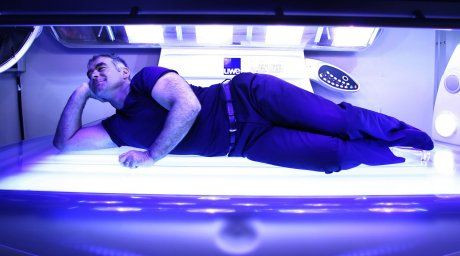Gene That Helps White Men Tan Also Increases Testicular Cancer Risk

We all know that too much sun exposure could lead to an increased risk of skin cancer, but could it also spell trouble for testicular cancer in Caucasian men? Research out of the U.S. National Institutes of Health and the University of Oxford in England has revealed that a gene associated with the skin’s tanning mechanism could increase a white male’s chance of developing testicular cancer.
“Gene variations occur naturally, and may become common in a population if they convey a health benefit,” said co-author of the study Douglas Bell, Ph.D., from the NIH’s National Institute of Environmental Health Sciences (NIEHS).
The p53 gene, also known as a tumor suppressor gene, is made up of protein that can successfully prevent the development and growth of a tumor. It stimulates the skin’s tanning mechanism when it is penetrated by ultraviolet light, therefore preventing the spread of cancerous cells. Dr. Bell and fellow author Xuting Wang, Ph.D., led of team researchers who combed through thousands of data sets based on gene variations.
The surplus of data included 20,000 p53 binding sites in the human genome, 10 million inherited genetic variations genotyped in the 1000 Genomes Project, and 62,000 genetic variations associated with human cancers identified in genome-wide association studies (GWAS). Although one variant in the p53 pathway showed a positive effect by initiating the tanning process to inhibit the spread of skin cancer cells, it also led to testicular cancer growth.
“It appears that this particular variant could help protect light-skinned individuals from UV skin damage, like burning or cancer, by promoting the tanning process, but it permits testicular stem cells to grow in the presence of DNA damage, when they are supposed to stop growing,” explained Dr. Bell.
The p53 gene stimulates tanning through melanocyte, which is produced by a DNA sequencing gene known as KIT ligand oncogene (KITLG). A research team from the Ludwig Institute for Cancer Research at the University of Oxford was tasked with identifying the p53 variant’s molecular mechanism that is linked to tanning and cancer.
“White males with a single nucleotide variation in KITLG, called the G allele, have the highest odds of having testicular cancer,” said lead researcher Gareth Bond, Ph.D. “The high frequency of this allele in light skin individuals may explain why testicular cancer is so much more frequent in people of European descent than those of African descent.”
While Dr. Bond identified a twofold to threefold increased risk of cancer development, there was some good news. G allele’s risk of cancer development could also explain why testicular tumors are successfully cured through chemotherapy treatments.
“Most other tumors have a mutant p53, but in these testicular cell tumors, the p53 is functioning properly, and the drugs used for testicular cancer appear to work in concert with p53’s tumor suppression function to kill the cancer cells,” Dr. Bond added.
Source: Wang X, Tomlinson I, Box N, De Val S, Bell D, Bond G. A Polymorphic p53 Response Element in KIT Ligand Influences Cancer Risk and Has Undergone Natural Selection. Cell. 2013.
Published by Medicaldaily.com



























